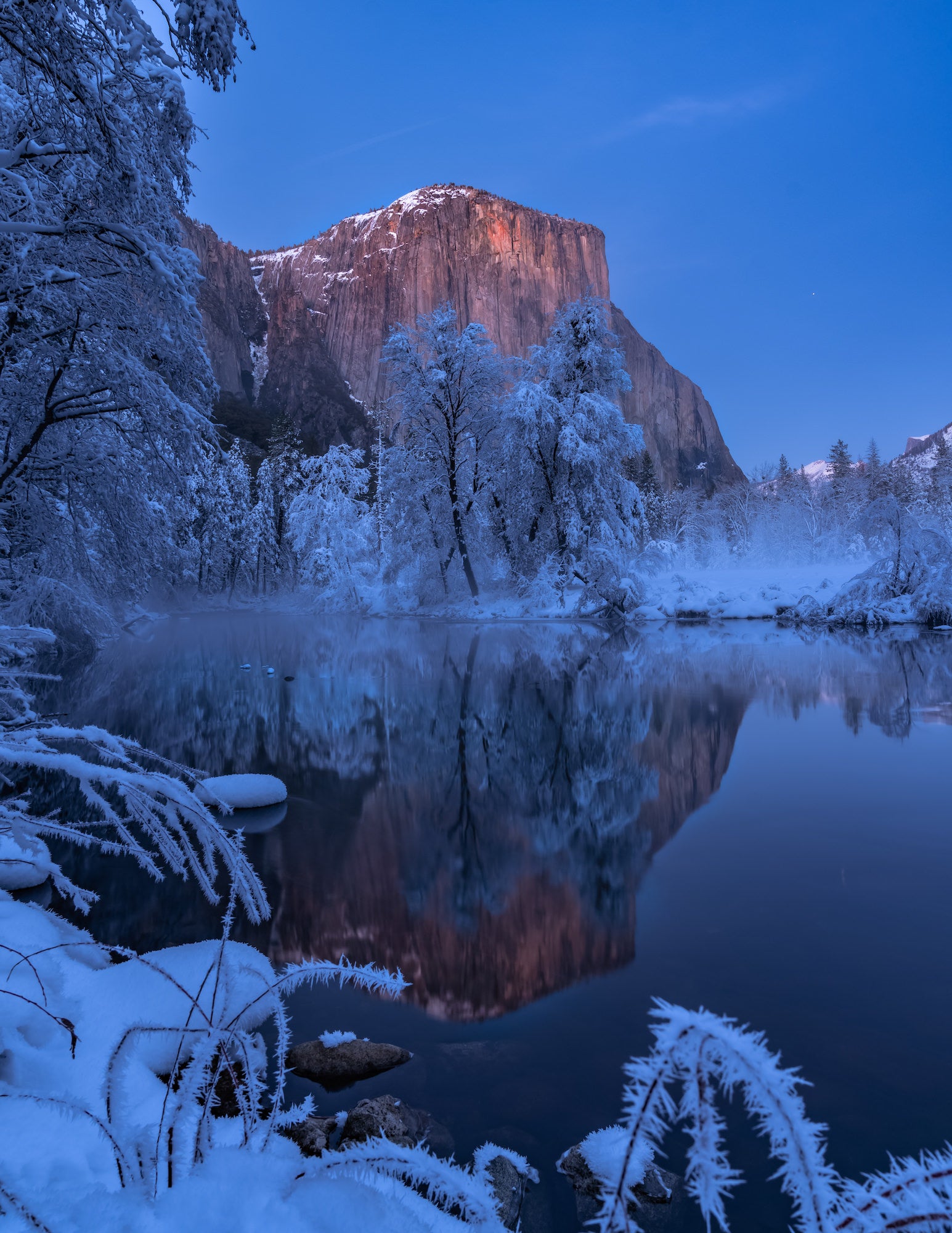Prasanna Pilaka is a landscape and street photographer who loves to chase sunlight in her hometown of San Francisco and beyond. She enjoys photographing landscapes as well as traveling to the wilderness. Spending time in nature gives her a free natural mental break and a great physical workout too. She can be found on Instagram, Facebook and TikTok (@prasannapilakaphotography, @prasannapilakaphotography and @prasannapilakaphotograph). She captured this beautiful blue-hour image int Yosemite National Park in mid-December 2022 after a winter storm which made the valley a true winter wonderland with breathtaking landscapes. Keep reading as she shares the story behind the shot.

Photo by Prasanna Pilaka. Sony Alpha 7R III. Sony 24-70mm f/2.8 G Master. 8-sec., f/7.1, ISO 50
We get the inside story behind a stunning blue hour image a photographer created with a Sony camera & lens duo that she says "has never let me down."
The Scene
Yosemite National Park is one of the most beautiful parks in California, especially in winter. I was fortunate enough to plan a three-day stay in the valley, at the beautiful and historic Ahwahnee Hotel. I booked my trip a month ahead so I had no idea whether I would get stuck in another winter storm, if the day would be beautiful or even if there would be any snow.
I was aiming for sunrises and sunsets in the valley during my stay. Most days, I shot for a few hours after the golden hour. The location of this shot is very popular for both golden hour times and I wanted to capture a blue hour (after sunset) shot. It was 19 degrees Fahrenheit after sunset with an amazing valley mist, a clear sky, and a slight breeze - perfect conditions for this shot.
The Gear
This image was captured using my Sony Alpha 7R III camera body and the Sony 24-70mm f/2.8 G Master lens. I love this lens; it always delivers. The lens is versatile for both landscape and portrait photography. Its aperture is perfect to get the bokeh in portraits and it also does Milky Way photography at its widest focal length of 24mm. It also has great low light performance making it great for astrophotography. I’ve had this camera body for over four years and the lens for two years. This duo has never let me down and I couldn’t be happier with them.
I used a Peak Design Carbon Fiber travel tripod which will forever accompany me when I leave my house. It’s lightweight and offers solid stability even in snow and breezy terrain. I have owned this tripod for over a year now and have used it almost every week.
How I Got The Shot
Some people think that landscape photography is easy, believing that you need only go to a location and start snapping away. I wish that were true. I spent several hours in Yosemite Valley wandering around the same roads multiple times to find the right conditions to capture the composition I had in mind. This image brings me tranquility and I must say that this location was really peaceful and majestic. I love photographing landscapes but it can be quite challenging and stressful at blue hour - when I’m dead tired shooting all day in the cold and the wind.
I love to shoot in vivid mode to capture eye-catching colorful landscapes, however, for this blue hour shot I used natural mode. I made several attempts in both horizontal and vertical modes on my tripod to get one perfect shot. While a horizontal mode shot would be quite pleasing, covering multiple mountains and a complete view of Yosemite Valley, I went for a vertical composition which showcased just one mountain, El Capitan, and its reflection in Merced river.
I always use manual mode and manual focus on a distant subject and lock in the focus. The aperture was f/7.1 as I wanted most of the trees, the frozen bushes in the foreground, and the mountain to be in focus, without the need for focus stacking. My camera settings for this shot were: 24mm, 8-sec., f/7.1, ISO 50.
A tripod was necessary for this shot as I went for an 8 second exposure to bring smoothness to the water with the mirror effect of El Capitan on the Merced river. I used ISO 50 as I want to reduce the noise that ISO can cause at low light. I also used my lens’ widest focal length, which is 24mm, allowing for the perfect vertical composition of this majestic landscape.
The Edit
This image was captured during blue hour. The important aspects were the Yosemite Valley mist, water reflection, and the snow-covered trees in the distance. The sky was a bit brighter and the overall water reflection didn’t appear mirror-like in the original (RAW) image as I had envisioned. During my post-processing, I adjusted this shot to appear more like the blue hour shot that it was while preserving clarity in the aspects mentioned above. These changes were made using Adobe Lightroom.
My usual edit workflow is as follows: Lens correction, crop, camera profile, Tone, HSL, and Noise Reduction adjustments, which I perform for all my low-light images. Then the general adjustments such as brightness, contrast, vibrance, etc.
For this particular picture, since it was cold and breezy, I used a Healing tool to remove any moisture marks from my shot. Added a Mask -> Brush to slightly increase the Exposure and Shadows of the mountain and its reflection in the water. And finally, another Mask -> Select Sky to slightly reduce the Exposure, Shadows, Whites, and Blacks.
See more of Prasanna Pilaka’s work on Instagram, Facebook and TikTok (@prasannapilakaphotography, @prasannapilakaphotography and @prasannapilakaphotograph).



